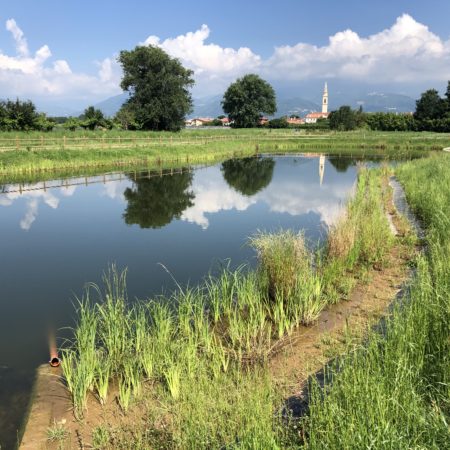The basin project provides for the insertion of a strip of marsh vegetation in a wide step along the edge, so as to interrupt the slope of the bank to avoid accidental falls in deep water. This strip will include species, typical of habitats that are disappearing in our environments, such as wet meadows (molinieti) and magnocarycetes. Among the species used, some are included in the regional red list of Veneto (Allium and Senecio), with a consequent strengthening of these in our territories and an increase in biodiversity.
Vegetazione presente nel bacino in ambito agricolo, località Giavenale
The project also foresees the construction of a micro-basin in the urban environment whose green furniture will also be cared for with some of the species indicated.
Both interventions, for their demonstrative value and for their replicability, will act as pilot interventions, destined to become examples replicable in other contests on the territory, multiplying their conservation value.
The benefits of vegetation
Urban areas are generally characterized by a high population density, the presence of large concreted and waterproofed surfaces, the absence or lack of open spaces and a high rate of anthropogenic activity, such as vehicular traffic, the presence of heating/cooling systems and industrial and production processes. This translates into high levels of pollution at all levels (air, water and soil).
The use of vegetation, particularly within natural water retention measures, makes urban environments healthier and more attractive to live in, thanks to the many benefits that this important component can provide.
- Improvement of air quality and reduction of greenhouse gas emissions. Vegetation not only produces oxygen through the process of photosynthesis, but also absorbs air pollutants from the air and intercepts the polluting particles (e.g. PM10) that are deposited on the surface of the leaves.
- Improvement of water quality. With special measures, the vegetation can promote Phyto depuration processes and reduce the presence of pollutants present in rainwater and in the water collected from impermeable urban surfaces. The soil, on which the vegetation grows and develops, also acts as a filter, improving the quality of the water that seeps into the subsoil.
- Reduction of the “heat island” effect. The heat island is a microclimatic phenomenon that leads to a rise in temperature in urban areas due to many factors (asphalt and concrete surfaces that absorb heat, presence of activities that produce heat, presence of buildings that impede the circulation of air). Vegetation can reduce this effect by intercepting and absorbing part of the solar radiation that would otherwise reach the surfaces below, through the process of evapotranspiration and, especially in the evening and night, cooling faster than asphalted areas.
- Creating habitats and increasing biodiversity. The inclusion of vegetated areas in the urban environment allows the creation of small habitats conducive to the establishment of animal species (especially birds and insects) contributing to improving the biodiversity of the urban ecosystem. This objective is pursued through a careful choice of plant species and by selecting primarily native varieties.
- Carbon capture and storage. Vegetation, through photosynthesis, captures and removes carbon dioxide from the atmosphere, contributing to the reduction of the greenhouse effect.
- Increasing the aesthetic value of the landscape. A careful use of vegetation in urban environments, through the selection and appropriate composition of native and non-native plant species, can significantly improve the aesthetic value of the areas in which they are inserted.
- Social benefits. There is ample evidence that interacting with nature produces positive effects on health, psychological well-being and cognitive functions.








